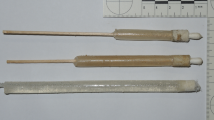Abstract
Bloodstain pattern analysis has a key role in crime scene reconstruction; however, it can be hampered by diverse confounding factors, such as insect activity which may lead to the production of small artifactual bloodstains, commonly referred to as fly artifacts (FA). Although several techniques aimed at distinguishing human bloodstains and FA have been developed, actually, no standardized and reproducible methodology is available. The aim of our study was to test the use of scanning electron microscopy (SEM) to distinguish human bloodstains from FA produced by Sarcophaga carnaria. FA and bloodstains have been produced on five different deposition surfaces under experimental conditions. After visual analysis, bloodstains and FA were analyzed at standard low (× 40–× 300) and high (× 600–× 1200) magnification through a Philips SEM 515. Although differential diagnosis between bloodstains and FA resulted often inconclusive at visual analysis, SEM analysis allowed the identification of additional key distinctive morphological features. In particular, on the surface of FA, small crystal-like and/or amorphous material deposits were observed. Such deposits were absent on bloodstains which, on the other hand, displayed red blood cells stacked in “rouleaux.” Basing on these results and under our experimental conditions, SEM analysis resulted suitable to perform a differential diagnosis between bloodstains and FA produced from the insect activity of Sarcophaga carnaria.


Similar content being viewed by others
References
Peschel O, Kunz SN, Rothschild MA, Mutzel E (2011) Blood stain pattern analysis. Forensic Sci Med Pathol 7(3):257–270. https://doi.org/10.1007/s12024-010-9198-1
Rivers D, Geiman T (2017) Insect artifacts are more than just altered bloodstains. Insects. 8(2). https://doi.org/10.3390/insects8020037
Pelletti G, Visentin S, Rago C, Cecchetto G, Montisci M (2017) Alteration of the death scene after self-stabbing: a case of sharp force suicide disguised by the victim as a homicide? J Forensic Sci 62:1395–1398. https://doi.org/10.1111/1556-4029.13440
Benecke M, Barksdale L (2003) Distinction of bloodstain patterns from fly artifacts. Forensic Sci Int 137(2–3):152–159
Striman B, Fujikawa A, Barksdale L, Carter DO (2011) Alteration of expirated bloodstain patterns by Calliphora vicina and Lucilia sericata (Diptera: Calliphoridae) through ingestion and deposition of artifacts. J Forensic Sci 56(Suppl 1):S123–S127. https://doi.org/10.1111/j.1556-4029.2010.01575.x
Bevel T, Gardner RM (2008) Bloodstain pattern analysis with an introduction to crime scene reconstruction. CRC press Taylor & Francis Group, Boca Raton
Lassaigne J (1856) Neue Untersuchung zur Erkennung von Blutflecken auf Eisen und Stahl (new investigation into blood stains on iron and steel). Vier Gericht Offent Med 10:285–289
Durdle A, Mitchell RJ, van Oorschot RA (2015) The use of forensic tests to distinguish blowfly artifacts from human blood, semen, and saliva. J Forensic Sci 60(2):468–470. https://doi.org/10.1111/1556-4029.12663
Langer SV, Illes M (2015) Confounding factors of fly artefacts in bloodstain pattern analysis. J Can Soc Forensic Sci 48(4):215–224. https://doi.org/10.1080/00085030.2015.1083306
Benecke M (2005) Arthropods and corpses. In: Tsokos M (ed) Forensic pathology reviews Volume 2, 1st edn. Springer Nature, Basel, pp 207–240
Durdle A, van Oorschot RA, Mitchell RJ (2013) The morphology of fecal and regurgitation artifacts deposited by the blow fly Lucilia cuprina fed a diet of human blood. J Forensic Sci 58(4):897–903. https://doi.org/10.1111/1556-4029.12145
Viero A, Montisci M, Pelletti G, Vanin S (2018) Crime scene and body alterations caused by arthropods: implications in death investigation. Int J Legal Med 24(10):018–1883
Fujikawa A, Barksdale L, Higley LG, Carter DO (2011) Changes in the morphology and presumptive chemistry of impact and pooled bloodstain patterns by Lucilia sericata (Meigen) (Diptera: Calliphoridae). J Forensic Sci 56(5):1315–1318. https://doi.org/10.1111/j.1556-4029.2011.01800.x
Fujikawa A, Barksdale L, Carter DO (2009) Calliphora vicina (Diptera: Calliphoridae) and their ability to alter the morphology and presumptive chemistry of bloodstain patterns. JFI 59(5):502
Durdle A, Mitchell RJ, van Oorschot RA (2013) The human DNA content in artifacts deposited by the blowfly Lucilia cuprina fed human blood, semen and saliva. Forensic Sci Int 233(1–3):212–219. https://doi.org/10.1016/j.forsciint.2013.09.015
Ristenbatt RR 3rd, Pizzola PA, Shaler RC, Sorkin LN (2003) Commentary on: Mark Benecke and Larry Barksdale, Distinction of bloodstain patterns from fly artifacts. Forensic Sci Int 137:152–159. Forensic Sci Int 2005;149(2–3):293–4. https://doi.org/10.1016/j.forsciint.2004.05.012
Rivers DB, Acca G, Fink M, Brogan R, Chen D, Schoeffield A (2018) Distinction of fly artifacts from human blood using immunodetection. J Forensic Sci 21(10):1556–4029
Rivers DB, McGregor A (2018) Morphological features of regurgitate and defecatory stains deposited by five species of necrophagous flies are influenced by adult diets and body size. J Forensic Sci 63(1):154–161
Zuha RM, Supriyani M, Omar B (2008) Fly artifact documentation of Chrysomya megacephala (Fabricius) (Diptera: Calliphoridae) - a forensically important blowfly species in Malaysia. Trop Biomed 25(1):17–22
Kulstein G, Amendt J, Zehner R (2015) Blow fly artifacts from blood and putrefaction fluid on various surfaces: a source for forensic STR typing. Entomol Exp Appl 157(3):255–262. https://doi.org/10.1111/eea.12365
Author information
Authors and Affiliations
Corresponding author
Ethics declarations
Conflict of interest
The authors declare that they have no conflict of interest.
Ethical approval
All procedures performed in this study were in accordance with the ethical standards of the national research committee (Bioethics Committee of the University of Bologna, Prot. 55171, 18/03/2019).
Informed consent
As fresh blood was used in this study, informed consent was obtained from all donors.
Additional information
Publisher’s note
Springer Nature remains neutral with regard to jurisdictional claims in published maps and institutional affiliations.
Rights and permissions
About this article
Cite this article
Pelletti, G., Mazzotti, M.C., Fais, P. et al. Scanning electron microscopy in the identification of fly artifacts. Int J Legal Med 133, 1575–1580 (2019). https://doi.org/10.1007/s00414-019-02090-5
Received:
Accepted:
Published:
Issue Date:
DOI: https://doi.org/10.1007/s00414-019-02090-5




